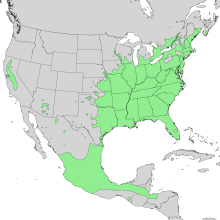Cephalanthus occidentalis
| Cephalanthus occidentalis | |
|---|---|

| |
| Cephalanthus occidentalis var. occidentalis blooming in Point Pelee National Park (Ontario, Canada). | |
| Scientific classification | |
| Kingdom: | Plantae |
| Clade: | Tracheophytes |
| Clade: | Angiosperms |
| Clade: | Eudicots |
| Clade: | Asterids |
| Order: | Gentianales |
| Family: | Rubiaceae |
| Genus: | Cephalanthus |
| Species: | C. occidentalis
|
| Binomial name | |
| Cephalanthus occidentalis | |
| Varieties | |
|
C. o. var. californicus | |

| |
| Natural range of Cephalanthus occidentalis[3] | |
Cephalanthus occidentalis is a species of flowering plant in the family Rubiaceae that is native to eastern and southern North America. Common names include buttonbush, common buttonbush, button-willow, buck brush, and honey-bells.
Description
Cephalanthus occidentalis is a
Taxonomy
There are two
- Cephalanthus occidentalis var. occidentalis (syn. var. pubescens) – common buttonbush. Eastern North America from Nova Scotia west to Minnesota and south to Florida and east Texas.
- Cephalanthus occidentalis var. californicus – California button-willow. Southwestern North America, from west Texas west to Sierra Nevada foothills, San Joaquin Valley, Sacramento Valley, and the Inner North Coast Ranges) and south to Mexico and Central America.
Habitat
Buttonbush is a common shrub of many wetland habitats in its range, including swamps, floodplains, mangrove, pocosin, riparian zones, and moist forest understory.[5] It is a member of the flora in the Everglades.[5]
Ecology
Distribution

The species occurs in eastern North America with disjunct populations occurring in the west. In Canada, it occurs from southern Ontario and Quebec east to New Brunswick and south-western Nova Scotia. Besides the eastern United States, and eastern regions of the Midwest, notable areas range into Arizona, the Mogollon Rim, and other mountain ranges; in California, the entire San Joaquin Valley[10] West of the Great Plains and the Rocky Mountains, only western Texas, Arizona, and California find C. occidentalis.
Uses
Medicinal
Cephalanthus occidentalis has a number of historical
Cultivation
Buttonbush is cultivated as an
Buttonbush is a suitable shrub for butterfly gardens.San Joaquin Valley landmark tree

The town of
References
- . Retrieved 6 May 2020.
- ^ "Cephalanthus occidentalis". Germplasm Resources Information Network. Agricultural Research Service, United States Department of Agriculture. Retrieved 2010-01-04.
- ^ "Cephalanthus occidentalis" (PDF). Digital Representations of Tree Species Range Maps from "Atlas of United States Trees" by Elbert L. Little, Jr. (and other publications). United States Geological Survey.
- ^ "Cephalanthus occidentalis L. buttonbush" (PDF). Wildland Shrubs of the United States and its Territories: Thamnic Descriptions. United States Forest Service. Archived from the original (PDF) on 26 March 2009. Retrieved 2009-09-14.
- ^ a b c d "Cephalanthus occidentalis". Fire Effects Information System. United States Forest Service.
- ISBN 0-394-50432-1.
- ISBN 0-394-50760-6.
- ^ a b "Common Buttonbush Cephalanthus occidentalis L." (PDF). Natural Resources Conservation Service Plant Guide. United States Department of Agriculture.
- ^ The Xerces Society (2016), Gardening for Butterflies: How You Can Attract and Protect Beautiful, Beneficial Insects, Timber Press.
- OCLC 4053799.
- ISBN 978-1-58017-571-5.
- ^ "CHL # 492 Buttonwillow Tree Kern". www.californiahistoricallandmarks.com.

